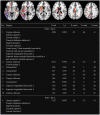Addiction as an Attachment Disorder: White Matter Impairment Is Linked to Increased Negative Affective States in Poly-Drug Use
- PMID: 28503141
- PMCID: PMC5408064
- DOI: 10.3389/fnhum.2017.00208
Addiction as an Attachment Disorder: White Matter Impairment Is Linked to Increased Negative Affective States in Poly-Drug Use
Abstract
Substance use disorders (SUD) have been shown to be linked to various neuronal and behavioral impairments. In this study, we investigate whether there is a connection between the integrity of white matter (WM) and attachment styles as well as different affective states including spirituality in a group of patients diagnosed for poly-drug use disorder (PUD) in comparison to non-clinical controls. A total sample of 59 right-handed men, comprising the groups of patients with PUD (n = 19), recreational drug-using individuals (RUC; n = 20) as well as non-drug using controls were recruited (NUC; n = 20). For the behavioral assessment, we applied the Adult Attachment-Scale, the Affective Neuroscience Personality-Scale (short version) and the Multidimensional Inventory for Religious/Spiritual Well-Being. Diffusion Tensor Imaging was used to investigate differences in WM neural connectivity. Analyses revealed decreased Fractional Anisotropy and decreased Mean Diffusivity in PUD patients as compared to RUC and NUC. No differences were found between RUC and NUC. Additional ROI analyses suggested that WM impairment in the superior longitudinal fasciculus (SLF) and the superior corona radiata (SCR) was linked to more insecure attachment as well as to more negative affectivity. No substantial correlation was observed with spirituality. These findings are mainly limited by the cross-sectional design of the study. However, our preliminary results support the idea of addiction as an attachment disorder, both at neuronal and behavioral levels. Further research might be focused on the changes of insecure attachment patterns in SUD treatment and their correlation with changes in the brain.
Keywords: DTI; affectivity; attachment; spirituality; substance misuse; white matter integrity.
Figures


Similar articles
-
Pinpointing Neural Correlates of Attachment in Poly-Drug Use: A Diffusion Tensor Imaging Study.Front Neurosci. 2020 Jun 11;14:596. doi: 10.3389/fnins.2020.00596. eCollection 2020. Front Neurosci. 2020. PMID: 32595448 Free PMC article.
-
White matter integrity in polydrug users in relation to attachment and personality: a controlled diffusion tensor imaging study.Brain Imaging Behav. 2016 Dec;10(4):1096-1107. doi: 10.1007/s11682-015-9475-4. Brain Imaging Behav. 2016. PMID: 26542619
-
Brain Structure Alterations in Poly-Drug Use: Reduced Cortical Thickness and White Matter Impairments in Regions Associated With Affective, Cognitive, and Motor Functions.Front Psychiatry. 2019 Sep 20;10:667. doi: 10.3389/fpsyt.2019.00667. eCollection 2019. Front Psychiatry. 2019. PMID: 31616326 Free PMC article.
-
The Role of Attachment in Poly-Drug Use Disorder: An Overview of the Literature, Recent Findings and Clinical Implications.Front Psychiatry. 2019 Aug 27;10:579. doi: 10.3389/fpsyt.2019.00579. eCollection 2019. Front Psychiatry. 2019. PMID: 31507461 Free PMC article. Review.
-
Attachment and Substance Use Disorders-Theoretical Models, Empirical Evidence, and Implications for Treatment.Front Psychiatry. 2019 Oct 15;10:727. doi: 10.3389/fpsyt.2019.00727. eCollection 2019. Front Psychiatry. 2019. PMID: 31681039 Free PMC article. Review.
Cited by
-
The Therapeutic Community: A Unique Social Psychological Approach to the Treatment of Addictions and Related Disorders.Front Psychiatry. 2020 Aug 6;11:786. doi: 10.3389/fpsyt.2020.00786. eCollection 2020. Front Psychiatry. 2020. PMID: 32848950 Free PMC article.
-
White matter integrity and functional connectivity in adolescents with a parental history of substance use disorder.Neuroimage Rep. 2021 Sep;1(3):100037. doi: 10.1016/j.ynirp.2021.100037. Epub 2021 Jul 22. Neuroimage Rep. 2021. PMID: 36320407 Free PMC article.
-
Pinpointing Neural Correlates of Attachment in Poly-Drug Use: A Diffusion Tensor Imaging Study.Front Neurosci. 2020 Jun 11;14:596. doi: 10.3389/fnins.2020.00596. eCollection 2020. Front Neurosci. 2020. PMID: 32595448 Free PMC article.
-
Comparison of Students With and Without Problematic Smartphone Use in Light of Attachment Style.Front Psychiatry. 2019 Sep 18;10:681. doi: 10.3389/fpsyt.2019.00681. eCollection 2019. Front Psychiatry. 2019. PMID: 31620031 Free PMC article.
-
Childhood Trauma, Personality, and Substance Use Disorder: The Development of a Neuropsychoanalytic Addiction Model.Front Psychiatry. 2020 Jun 9;11:531. doi: 10.3389/fpsyt.2020.00531. eCollection 2020. Front Psychiatry. 2020. PMID: 32581894 Free PMC article.
References
LinkOut - more resources
Full Text Sources
Other Literature Sources
Miscellaneous

